Development, Organoleptic Evaluation and Acceptability of Products Developed from Agro Based Wastes-Seeds and Rind of Watermelon
Amatullah Quadri*, Avanti Rao
Department of Nutrition and Dietetics, Madina Degree and PG College for Women, Himayathnagar, Hyderabad, India
*Corresponding Author: Amatullah Quadri, Department of Nutrition and Dietetics, Madina Degree and PG College for Women, Himayathnagar, Hyderabad, India
Received: 08 October 2018; Accepted: 24 October 2018; Published: 14 November 2018
Article Information
Citation: Amatullah Quadri, Avanti Rao. Development, Organoleptic evaluation and Acceptability of Products Developed from Agro Based Wastes-Seeds and Rind of Watermelon. Journal of Food Science and Nutrition Research 1 (2018): 001-009.
DOI: 10.26502/jfsnr.2642-1100001
View / Download Pdf Share at FacebookAbstract
The aim of the present study was to utilize, develop and evaluate value added products of agro based waste-seeds and rind of watermelon. In view of its high nutritional content, they have very good potential food value to serve as supplements in food formulations. Four products were developed (Juice, Salad, Jam and Protein bars) along with their respective variations, from which Juice and Salad were subjected only for numerical scoring whereas Jam and Protein bars were subjected to detailed hedonic scaling. Protein bars containing ragi flakes and jam made only with Watermelon rind were the most acceptable amongst the three and two respective formulations. Statistical analysis was applied and fudicial limits of the above mentioned parameters were obtained.
The scores obtained for overall acceptability were analysed using ‘t’ test. It was found that the calculated value (2.83) was greater than the table value (1.64) at 5% level of significance. Hence there is no significant difference observed between the two variations of jam and in Protein bars it was found that Variation 1 (4.07) and Variation 3 (5.55) are highly significant and Variation 2 (1.65) is significant at 5% level significance. Thus, the present study concluded that seeds and the rind of watermelon could be successfully incorporated in jam and protein bars without affecting the sensory or nutritional quality of finished product. It can be consumed by all age groups during breakfast (jam) or snack time.
Keywords
Agro waste, Watermelon seeds, Watermelon rind
Agro waste articles, Watermelon seeds articles, Watermelon rind articles
Agro waste articles Agro waste Research articles Agro waste review articles Agro waste PubMed articles Agro waste PubMed Central articles Agro waste 2023 articles Agro waste 2024 articles Agro waste Scopus articles Agro waste impact factor journals Agro waste Scopus journals Agro waste PubMed journals Agro waste medical journals Agro waste free journals Agro waste best journals Agro waste top journals Agro waste free medical journals Agro waste famous journals Agro waste Google Scholar indexed journals Watermelon seeds articles Watermelon seeds Research articles Watermelon seeds review articles Watermelon seeds PubMed articles Watermelon seeds PubMed Central articles Watermelon seeds 2023 articles Watermelon seeds 2024 articles Watermelon seeds Scopus articles Watermelon seeds impact factor journals Watermelon seeds Scopus journals Watermelon seeds PubMed journals Watermelon seeds medical journals Watermelon seeds free journals Watermelon seeds best journals Watermelon seeds top journals Watermelon seeds free medical journals Watermelon seeds famous journals Watermelon seeds Google Scholar indexed journals Watermelon rind articles Watermelon rind Research articles Watermelon rind review articles Watermelon rind PubMed articles Watermelon rind PubMed Central articles Watermelon rind 2023 articles Watermelon rind 2024 articles Watermelon rind Scopus articles Watermelon rind impact factor journals Watermelon rind Scopus journals Watermelon rind PubMed journals Watermelon rind medical journals Watermelon rind free journals Watermelon rind best journals Watermelon rind top journals Watermelon rind free medical journals Watermelon rind famous journals Watermelon rind Google Scholar indexed journals nutritional content articles nutritional content Research articles nutritional content review articles nutritional content PubMed articles nutritional content PubMed Central articles nutritional content 2023 articles nutritional content 2024 articles nutritional content Scopus articles nutritional content impact factor journals nutritional content Scopus journals nutritional content PubMed journals nutritional content medical journals nutritional content free journals nutritional content best journals nutritional content top journals nutritional content free medical journals nutritional content famous journals nutritional content Google Scholar indexed journals protein bar articles protein bar Research articles protein bar review articles protein bar PubMed articles protein bar PubMed Central articles protein bar 2023 articles protein bar 2024 articles protein bar Scopus articles protein bar impact factor journals protein bar Scopus journals protein bar PubMed journals protein bar medical journals protein bar free journals protein bar best journals protein bar top journals protein bar free medical journals protein bar famous journals protein bar Google Scholar indexed journals ragi flakes articles ragi flakes Research articles ragi flakes review articles ragi flakes PubMed articles ragi flakes PubMed Central articles ragi flakes 2023 articles ragi flakes 2024 articles ragi flakes Scopus articles ragi flakes impact factor journals ragi flakes Scopus journals ragi flakes PubMed journals ragi flakes medical journals ragi flakes free journals ragi flakes best journals ragi flakes top journals ragi flakes free medical journals ragi flakes famous journals ragi flakes Google Scholar indexed journals nutritional facts articles nutritional facts Research articles nutritional facts review articles nutritional facts PubMed articles nutritional facts PubMed Central articles nutritional facts 2023 articles nutritional facts 2024 articles nutritional facts Scopus articles nutritional facts impact factor journals nutritional facts Scopus journals nutritional facts PubMed journals nutritional facts medical journals nutritional facts free journals nutritional facts best journals nutritional facts top journals nutritional facts free medical journals nutritional facts famous journals nutritional facts Google Scholar indexed journals bajra flakes articles bajra flakes Research articles bajra flakes review articles bajra flakes PubMed articles bajra flakes PubMed Central articles bajra flakes 2023 articles bajra flakes 2024 articles bajra flakes Scopus articles bajra flakes impact factor journals bajra flakes Scopus journals bajra flakes PubMed journals bajra flakes medical journals bajra flakes free journals bajra flakes best journals bajra flakes top journals bajra flakes free medical journals bajra flakes famous journals bajra flakes Google Scholar indexed journals cumin powder articles cumin powder Research articles cumin powder review articles cumin powder PubMed articles cumin powder PubMed Central articles cumin powder 2023 articles cumin powder 2024 articles cumin powder Scopus articles cumin powder impact factor journals cumin powder Scopus journals cumin powder PubMed journals cumin powder medical journals cumin powder free journals cumin powder best journals cumin powder top journals cumin powder free medical journals cumin powder famous journals cumin powder Google Scholar indexed journals
Article Details
1. Introduction
The most common problems in food processing is the disposal of the sub-products generated. This "waste material" produces ecological problems related to the proliferation of insects and rodents and an economic burden because of transportation to repositories. Therefore strategies for the profitable use of this material are needed. In recent times more attention has been focused to recover valuable components from neglected food parts (food “losses”, “wastes”, “by-products” or “wasted by-products”) and recycle them inside the food chain, in an economic and sustainable way. The juice or pulp from watermelon is considered as the edible portion but rind and seeds are discarded as major solid wastes [1-2]. Watermelon seeds are known to be highly nutritional; they are rich sources of protein, B vitamins, minerals (such as magnesium, potassium, phosphorous, sodium, iron, zinc, manganese and copper) and fat among others as well as phytochemicals. The seeds of watermelons are known to have economic benefits especially in countries where cultivation is on the increase. Watermelon rind contains citrulline, a non-essential amino acid, which converts to L-arginine when eaten.
2. Materials and Methods
2.1 Procurement of the raw material
The raw materials required for the preparation of the products were procured from a supermarket named Ratnadeep at Tolichowki, Hyderabad. Watermelon and watermelon seeds were procured from a local market from Mehdipatnam, Hyderabad.
2.2 Standardization of the recipe
Standardization is the process where a recipe is tested number of times and found a satisfactory in quantity and yield. It is a gradual trial process. The standardization procedure was carried out by repeated trials till an acceptable recipe for the preparation of the product was obtained. The amounts were finalized by assessing the appearance, texture and taste of the variations. The finalized products were jam, juice, salad and protein bar.
Amounts of all the ingredients in the formulation of different products:
Variation 1 |
Variation 2 |
||
|
Watermelon seeds |
30 gm |
Watermelon seeds |
30 gm |
|
Watermelon rind |
100 gm |
Watermelon rind |
100 gm |
|
Sugar |
60 gm |
Sugar |
60 gm |
|
Cinnamon |
5 gm |
Apple |
60 gm |
|
Lemon juice |
5 ml |
Raspberry food color |
1 ml |
|
Vanilla essence |
2.5 ml |
Vanilla essence |
2.5 ml |
Table 1: Product name: JAM.
|
Variation 1 |
Variation 2 |
Variation 3 |
|||
|
Watermelon seeds |
20 gm |
Watermelon seeds |
20 gm |
Watermelon seeds |
20 gm |
|
Watermelon rind |
100 gm |
Watermelon rind |
100 gm |
Watermelon rind |
100 gm |
|
Salt |
2 gm |
Salt |
2 gm |
Salt |
2 gm |
|
Lemon juice |
5 ml |
Cumin powder |
3 gm |
Mint juice |
5 ml |
Table 2: Product name: JUICE.
|
Variation 1 |
Variation 2 |
Variation 3 |
|||
|
Watermelon seeds |
20 gm |
Watermelon seeds |
20 gm |
Watermelon seeds |
20 gm |
|
Watermelon rind |
100 gm |
Watermelon rind |
100 gm |
Watermelon rind |
100 gm |
|
Curd |
25 gm |
Curd |
25 gm |
Curd |
25 gm |
|
Cream |
15 gm |
Cream |
15 gm |
Cream |
15 gm |
|
Sugar |
15 gm |
Sugar |
15 gm |
Sugar |
15 gm |
|
Salt |
3 gm |
Salt |
3 gm |
Salt |
3 gm |
|
Mustard powder |
5 gm |
Mustard powder |
5 gm |
Mustard powder |
5 gm |
|
Pineapple |
100 gm |
Strawberry |
100 gm |
Papaya |
100 gm |
Table 3: Product name: SALAD.
|
Variation 1 |
Variation 2 |
Variation 3 |
|||
|
Watermelon seeds |
5 gm |
Watermelon seeds |
5 gm |
Watermelon seeds |
5 gm |
|
Watermelon rind |
5 gm |
Watermelon rind |
5 gm |
Watermelon rind |
5 gm |
|
Dates |
10 gm |
Dates |
10 gm |
Dates |
10 gm |
|
Ragi flakes |
20 gm |
Jowar flakes |
20 gm |
Bajra flakes |
20 gm |
Table 4: Product name: PROTEIN BARS.
3. Method of preparation
3.1 Jam Variation 1:
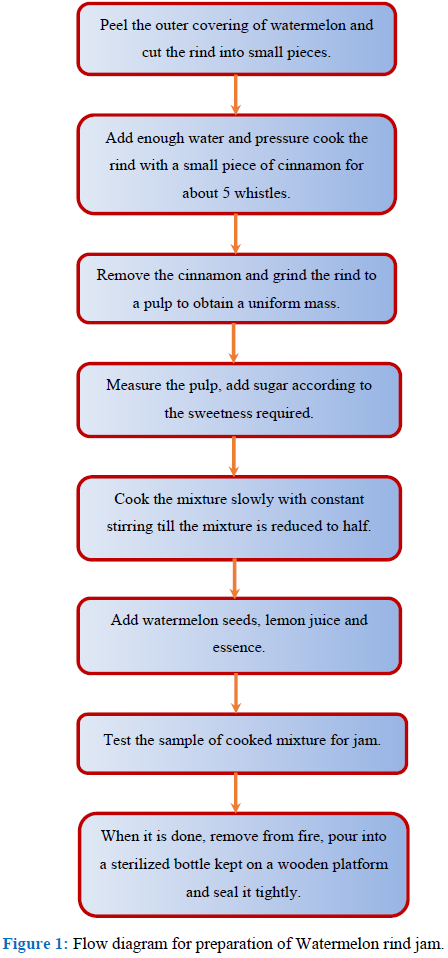
Figure 1
3.2 Variation 2: (Apple)
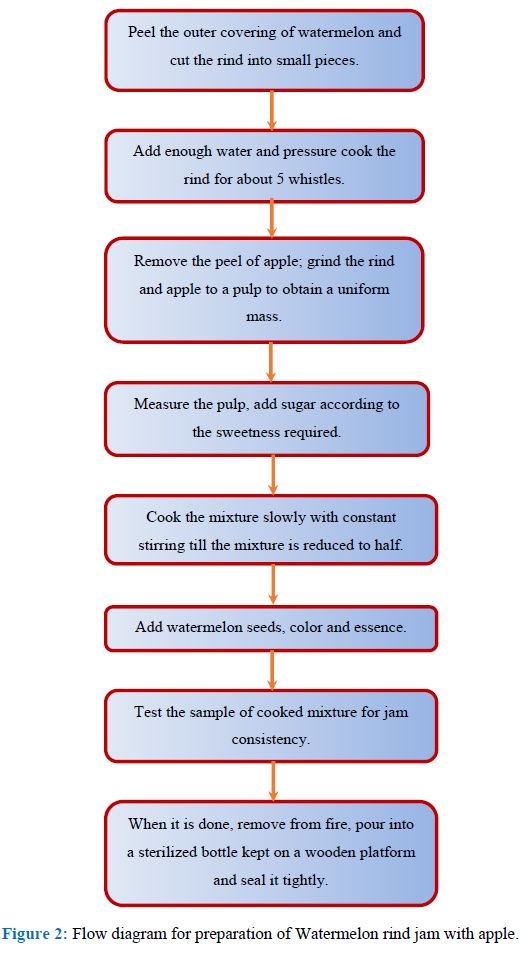
Figure 2
3.3 Juice Variation 1: (Lemon juice)
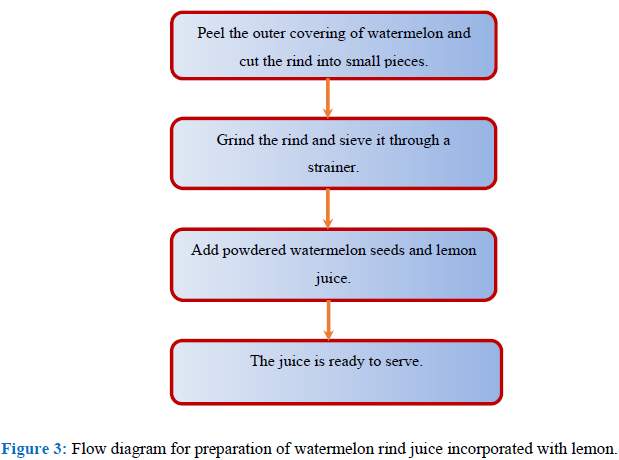
Figure 3
Note: The method of preparation for variation 2 and variation 3 is same as variation 1 besides adding cumin powder and mint juice.
3.4 Salad Variation 1: (Pineapple)
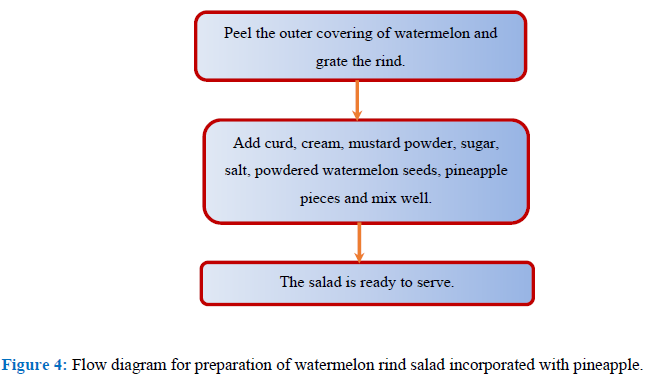
Figure 4
Note: The method of preparation for variation 2 and variation 3 is same as variation 1 besides adding strawberry and papaya.
3.5 Protein bars Variation 1: (Ragi)
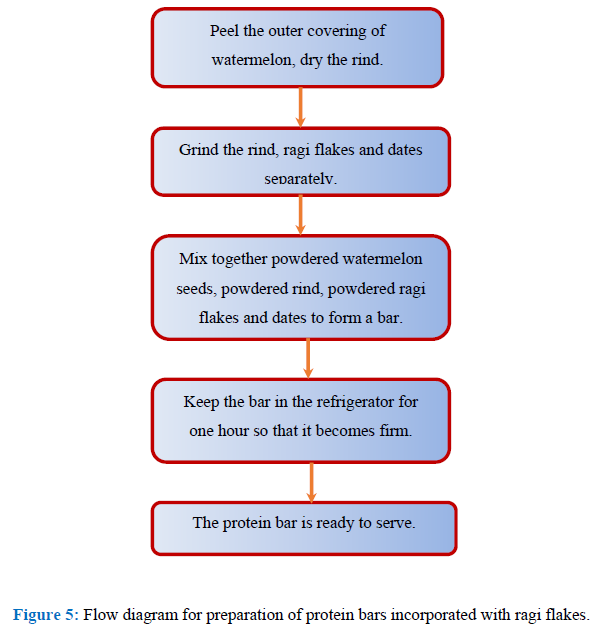
Figure 5
Note: The method of preparation for variation 2 and variation 3 is same as variation 1 besides adding jowar flakes and ragi flakes.
3.6 Sensory evaluation of the developed products
The sensory evaluation of the five developed samples (Jam-2; Protein bar-3) was carried out by 70 semi-trained panelists. The panelists made hedonic evaluation of the samples and were asked to assess the jam and protein bars for overall acceptability based on the color, taste and texture.
3.7 Statistical analysis of nutrient content of the products
Moisture Analysis was followed by Ashing. After dry ashing is done, incineration at high temperature (525?C or higher) accomplished in a muffle furnace. Estimation of mineral content such as and Iron (Fe), Calcium (Ca) were performed using titrimetric method. The iron content in protein bar with bajra flakes (Variation 3) is the highest (0.92mg/100g) and least is Variation 1 with ragi flakes (0.61mg/100g). The calcium content in protein bar with ragi flakes (Variation 1) is the highest (88.3mg/100g) and least is Variation 2 with jowar flakes (0.61mg/100g).
4. Results and Discussion
It has been found that the mean scores of Jam for color of Variation 1 (7.9) was greater than Variation 2 (7.6). The flavor of Variation 2 (7.5) was greater than Variation 1 (7.3). The texture of Variation 2 (7.4) was greater than Variation 1 (7.3). The taste of Variation 2 (7.5) was greater than Variation 1 (7.3). The overall acceptability of Variation 2 (7.6) was greater than Variation 1 (7.4).
The data was analysed by using Analysis of Variance (ANOVA) test and the calculated value (0.875) was less than the table value. Hence there was no significant difference observed at1% and 5% level of significance. The Duncan’s Multiple Range test (DMRT) showed the results that Variation 2 was non-significant from Variation 1. The scores obtained for overall acceptability were analysed using ‘t’ test. It was found that the calculated value (2.83) was greater than the table value (1.64) at 5% level of significance. Hence there is significant difference observed between the two variations of jam.
The mean scores of Protein bars for color of Variation 1 (8.1) was greatest followed Variation 2 (7.9) and the least acceptable was Variation 3 (7.6). The flavor of Variation 1 (8.0) was greatest followed Variation 2 (7.6) and the least acceptable was Variation 3 (7.4). The texture of Variation 1 (8.1) was greatest followed Variation 2 (7.8) and the least acceptable was Variation 3 (7.7). The taste of Variation 1 (8.0) was greatest followed Variation 2 (7.4) and the least acceptable was Variation 3 (7.2). The overall acceptability of Variation 1 (8.1) was greatest followed Variation 2 (7.5) and the least acceptable was Variation 3 (7.2).
The data was analyzed by using Analysis of Variance (ANOVA) test and the calculated value (2.18) was less than the table value. Hence there was no significant difference observed at 1% and 5% level of significance. The Duncan’s Multiple Range test (DMRT) showed the results that Variation 2 (jowar flakes) was significantly different from Variation 3 (bajra flakes) whereas Variation 1 (ragi flakes) was non-significant from Variation 2 (jowar flakes). The data was analysed by ‘t’ test which showed that all three variations are significantly different from other (4.07; 1.65; 5.55) at 5% level significance.
5. Conclusion
It can be concluded that Variation 2 (watermelon rind jam) of Jam and Variation 1 (ragi flakes) of Protein bars have the highest consumer acceptability. Hence, there is a significant potential for the development of value added products from watermelon seeds and rind. It’s promising nutritional facts gives warranty for further studies to increase the dietary use of these food wastes and reduce the attendant burden in the environment.
References
- Bawa As, Bains Gs. Integrated processing of watermelons for juice and seed. Indian food packer 31 (1977): 12-15.
- Reetapa Biswas, Tiyasa Dey, Santa Dutta (De). A comprehensive review on watermelon seed-the spitted one. International Journal of Current Research 8 (2016): 35828-35832.
- Agnes M Rimando, Penelope M Perkins-Veazie. Determination of citrulline in watermelon rind. Journal of Chromatography A 3 (2005): 196-200.
- Gladvin G, Sudhaakr G, Swathi V et al. Mineral and Vitamin Compositions Contents in Watermelon Peel (Rind). International Journal of Current Microbiology and Applied Sciences 5 (2017): 129-133.


 Impact Factor: * 3.8
Impact Factor: * 3.8 Acceptance Rate: 77.96%
Acceptance Rate: 77.96%  Time to first decision: 10.4 days
Time to first decision: 10.4 days  Time from article received to acceptance: 2-3 weeks
Time from article received to acceptance: 2-3 weeks 